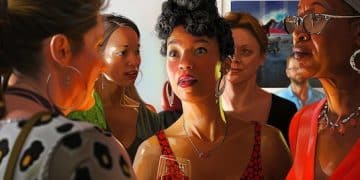The Importance of Diversity in Film: Celebrating Representation on Screen

The importance of diversity in film lies in its power to reflect society accurately, challenge stereotypes, and provide opportunities for underrepresented groups, enriching storytelling and fostering a more inclusive cinematic landscape.
Discover the importance of diversity in film: celebrating representation on screen not only enriches storytelling but also reflects the diverse world we live in, offering a more inclusive and equitable cinematic experience.
Why Diversity in Film Matters
The representation of diverse characters and stories in film is more than just a trend; it’s a fundamental shift towards reflecting the world as it truly is. Embracing diversity on screen allows for a broader range of perspectives, experiences, and narratives to be shared, challenging traditional norms and stereotypes.
From a social standpoint, diverse representation helps to normalize differences and promote understanding and empathy among viewers. When people see themselves reflected in the stories they watch, it fosters a sense of belonging and validation, contributing to a more inclusive and equitable society.
Culturally, diverse films can introduce audiences to new traditions, histories, and viewpoints, broadening their understanding of the world and fostering appreciation for different cultures. This exposure can lead to greater cross-cultural dialogue and collaboration.

Social Impact of Diverse Representation
Diverse representation in film can have a profound impact on society, influencing perceptions, attitudes, and behaviors. Studies have shown that seeing diverse characters on screen can reduce prejudice and promote empathy, especially among younger viewers.
Furthermore, diverse representation provides role models for marginalized communities, inspiring individuals to pursue their dreams and break down barriers. When young people see people who look like them achieving success in film, it reinforces the message that anything is possible.
Cultural Enrichment Through Varied Narratives
Diverse films offer a window into different cultures and experiences, enriching our understanding of the world. By showcasing stories from various backgrounds, filmmakers can challenge stereotypes, promote cultural exchange, and foster appreciation for different traditions.
- Breaking Stereotypes: Diverse films challenge stereotypes by portraying characters with depth and complexity, rather than reducing them to harmful tropes.
- Promoting Understanding: By humanizing different cultures and communities, diverse films can promote understanding and empathy among viewers.
- Cultural Exchange: Diverse films can introduce audiences to new traditions, languages, and customs, fostering cultural exchange and appreciation.
- Global Perspectives: Diverse films can offer global perspectives on social and political issues, broadening our understanding of the world.
In conclusion, the importance of diversity in film extends far beyond mere representation; it shapes perceptions, attitudes, and behaviors, fostering a more inclusive, understanding, and culturally rich society.
Boosting Creativity and Innovation
Diversity in film is not just a social imperative; it’s also a catalyst for creativity and innovation. When filmmakers bring different perspectives, experiences, and backgrounds to the table, it leads to more original and thought-provoking stories.
Diverse teams are better equipped to identify new audiences, tap into untapped markets, and create films that resonate with a wider range of viewers. This can lead to increased box office success and greater critical acclaim.
Moreover, diverse filmmakers are more likely to challenge conventional storytelling techniques and push the boundaries of cinematic art. This can result in more experimental, innovative, and groundbreaking films that redefine what’s possible in cinema. By having people with varied lived realities creating content, the scope of what gets created expands greatly.
Diverse Teams, Diverse Stories
When film crews are composed of diverse individuals, it’s more likely that the stories they tell will reflect a wide range of experiences and perspectives. This can lead to more authentic, nuanced, and compelling narratives.
- Authenticity: Diverse teams can bring greater authenticity to the screen by drawing on their own personal experiences and cultural knowledge.
- Nuance: Diverse teams can offer different perspectives on complex issues, resulting in more nuanced and thought-provoking stories.
- Compelling Narratives: Diverse teams can tap into untapped markets and create films that resonate with a wider range of viewers.
Challenging Conventional Storytelling
Diverse filmmakers are more likely to challenge conventional storytelling techniques and push the boundaries of cinematic art. This can lead to more experimental, innovative, and groundbreaking films that redefine what’s possible in cinema.
In conclusion, diversity in film is a powerful driver of creativity and innovation, leading to more original, thought-provoking, and groundbreaking stories that resonate with a wider range of viewers.

Economic Benefits of Diversity in Film
Beyond the social and cultural benefits, diversity in film also makes good business sense. Films that feature diverse casts and stories have been shown to perform better at the box office, attracting larger audiences and generating higher revenues.
This is because diverse films appeal to a broader range of viewers, who are increasingly seeking out stories that reflect their own experiences and values. Furthermore, diverse films can tap into underserved markets, attracting new audiences and expanding the reach of cinema.
Studios and distributors are beginning to recognize the economic potential of diversity and are investing in more diverse projects. This trend is likely to continue as audiences become more diverse and demand more inclusive storytelling. Diverse films are often created on a lower budget initially, allowing them to take more innovative risks as well since the studio can take more chances.
Attracting Larger Audiences
Diverse films attract larger audiences by appealing to a broader range of viewers. This includes people of color, women, LGBTQ+ individuals, and other marginalized communities who have historically been underrepresented in film, along with the allies who choose to support these movies.
Tapping into Underserved Markets
Diverse films can tap into underserved markets by telling stories that resonate with specific cultural groups or communities. This can lead to new audiences and increased revenue.
- Authenticity: Diverse films that are authentic to the cultures and communities they represent are more likely to resonate with those audiences.
- Marketing: Targeted marketing campaigns can help to reach specific audiences and generate interest in diverse films.
- Distribution: Diverse films need to be distributed in a way that makes them accessible to the audiences they are intended to reach.
In conclusion, diversity in film is not just a social imperative; it’s also a smart business strategy. Films that embrace diversity can attract larger audiences, tap into underserved markets, and generate higher revenues, making it a win-win for both filmmakers and audiences.
Challenging Stereotypes and Promoting Empathy
One of the most significant contributions of diversity in film is its ability to challenge stereotypes and promote empathy. By portraying characters with nuance and complexity, diverse films can break down harmful generalizations and foster a deeper understanding of different cultures and communities.
When viewers see diverse characters on screen, they are more likely to see them as individuals rather than as representatives of a particular group. This can help to reduce prejudice and discrimination, and promote greater tolerance and respect for differences.
Moreover, diverse films can help viewers to understand the experiences of others by putting them in the shoes of characters from different backgrounds. This can foster empathy and compassion, leading to greater understanding and connection.
Breaking Down Harmful Generalizations
Diverse films challenge stereotypes by portraying characters with depth and complexity. This includes showing their strengths, weaknesses, hopes, and fears, rather than reducing them to simplistic caricatures.
Fostering Understanding and Connection
Diverse films can help viewers to understand the experiences of others by putting them in the shoes of characters from different backgrounds. This can foster empathy and compassion, leading to greater understanding and connection.
In conclusion, diversity in film is a powerful tool for challenging stereotypes and promoting empathy. By portraying characters with nuance and complexity, diverse films can break down harmful generalizations and foster a deeper understanding of different cultures and communities.
Expanding Opportunities for Underrepresented Groups
Promoting diversity in film is not just about representation on screen; it’s also about expanding opportunities for underrepresented groups behind the camera. This includes providing more opportunities for people of color, women, LGBTQ+ individuals, and other marginalized communities to work as directors, writers, producers, and crew members.
When underrepresented groups have a greater say in the stories that are told, it leads to more authentic and nuanced portrayals of their experiences. It also helps to create a more equitable and inclusive film industry.
Many organizations and initiatives are working to promote diversity behind the camera, including mentorship programs, training programs, and funding opportunities for diverse filmmakers. These efforts are helping to level the playing field and create a more diverse and vibrant film industry.
More Inclusive Hiring Practices
One of the most effective ways to promote diversity behind the camera is to implement more inclusive hiring practices. This includes actively seeking out diverse candidates, providing equal opportunities for advancement, and creating a welcoming and supportive work environment.
- Diversity Targets: Setting diversity targets can help to ensure that studios and production companies are actively working to create a more diverse workforce.
- Mentorship Programs: Mentorship programs can help to support and guide underrepresented individuals as they navigate their careers in the film industry.
- Training Programs: Training programs can provide underrepresented individuals with the skills and knowledge they need to succeed in the film industry.
Empowering Diverse Voices
Another important way to promote diversity behind the camera is to empower diverse voices by giving them more creative control over the stories that are told. This includes supporting diverse filmmakers, writers, and producers, and giving them the resources they need to succeed.
- Funding Opportunities: Funding opportunities can provide diverse filmmakers with the financial resources they need to make their films.
- Creative Control: Diverse filmmakers should have creative control over their films, ensuring that their stories are told authentically.
- Distribution Support: Diverse films should receive distribution support, ensuring that they reach a wide audience.
In conclusion, promoting diversity in film is not just about representation on screen; it’s also about expanding opportunities for underrepresented groups behind the camera. By implementing more inclusive hiring practices and empowering diverse voices, we can create a more equitable, inclusive, and vibrant film industry.
Future of Diversity in Film
The future of diversity in film looks promising, as audiences become more diverse and demand more inclusive storytelling. Studios and distributors are beginning to recognize the importance of diversity and are investing in more diverse projects.
As technology advances, new opportunities are emerging for diverse filmmakers to create and distribute their work. Streaming platforms are providing a wider audience for diverse films, and social media is allowing filmmakers to connect directly with their fans.
However, there is still much work to be done to ensure that the film industry truly reflects the diversity of the world we live in. Ongoing efforts are needed to promote diversity both on and off screen, and to create a more equitable and inclusive film industry for all.
The Role of Streaming Platforms
Streaming platforms are playing an increasingly important role in promoting diversity in film. These platforms provide a wider audience for diverse films, and they are often more willing to take risks on projects that might not be financially viable in traditional theatrical releases.
Ongoing Efforts and Initiatives
Many organizations and initiatives are working to promote diversity in film, including mentorship programs, training programs, and funding opportunities for diverse filmmakers. These efforts are helping to level the playing field and create a more diverse and vibrant film industry.
- Advocacy Groups: Advocacy groups are working to raise awareness of the importance of diversity in film and to push for more inclusive practices.
- Industry Initiatives: Industry initiatives, such as the Academy Awards’ diversity requirements, are helping to create more accountability and drive change.
- Grassroots Movements: Grassroots movements are empowering diverse filmmakers and giving them a voice in the industry.
In conclusion, the future of diversity in film is bright, but it requires ongoing efforts and initiatives to ensure that the film industry truly reflects the diversity of the world we live in. By embracing diversity both on and off screen, we can create a more equitable, inclusive, and vibrant cinematic landscape for all.
| Key Aspect | Brief Description |
|---|---|
| 🧑🤝🧑 Social Impact | Promotes empathy and reduces prejudice through diverse representation. |
| 🎬 Creative Boost | Diverse teams bring unique perspectives, fostering innovation. |
| 💰 Economic Gains | Diverse films attract larger audiences and increase revenue. |
| 🤝 Opportunities | Expands roles for underrepresented groups behind the camera. |
FAQ
▼
Diversity in film reflects the real world, promotes inclusivity, challenges stereotypes, and provides opportunities for underrepresented groups, enriching storytelling and fostering empathy among viewers.
▼
Diverse teams bring varied experiences and perspectives, resulting in more original and innovative stories that resonate with a wider audience, pushing the boundaries of cinematic art.
▼
Diverse films attract larger audiences, tap into underserved markets, and generate higher revenues, making them commercially successful investments for studios and distributors.
▼
Diverse films portray characters with nuance and complexity, breaking down harmful generalizations and promoting a deeper understanding of different cultures and communities, fostering empathy.
▼
The future looks promising with increasing demand for inclusive storytelling, technological advancements, and ongoing efforts to promote diversity on and off-screen, creating a more equitable film industry.
Conclusion
In conclusion, the importance of diversity in film: celebrating representation on screen cannot be overstated. It enriches storytelling, promotes empathy, drives creativity, and makes good business sense. By embracing diversity both on and off screen, we can create a more inclusive and vibrant cinematic world that reflects the richness and complexity of the human experience.





